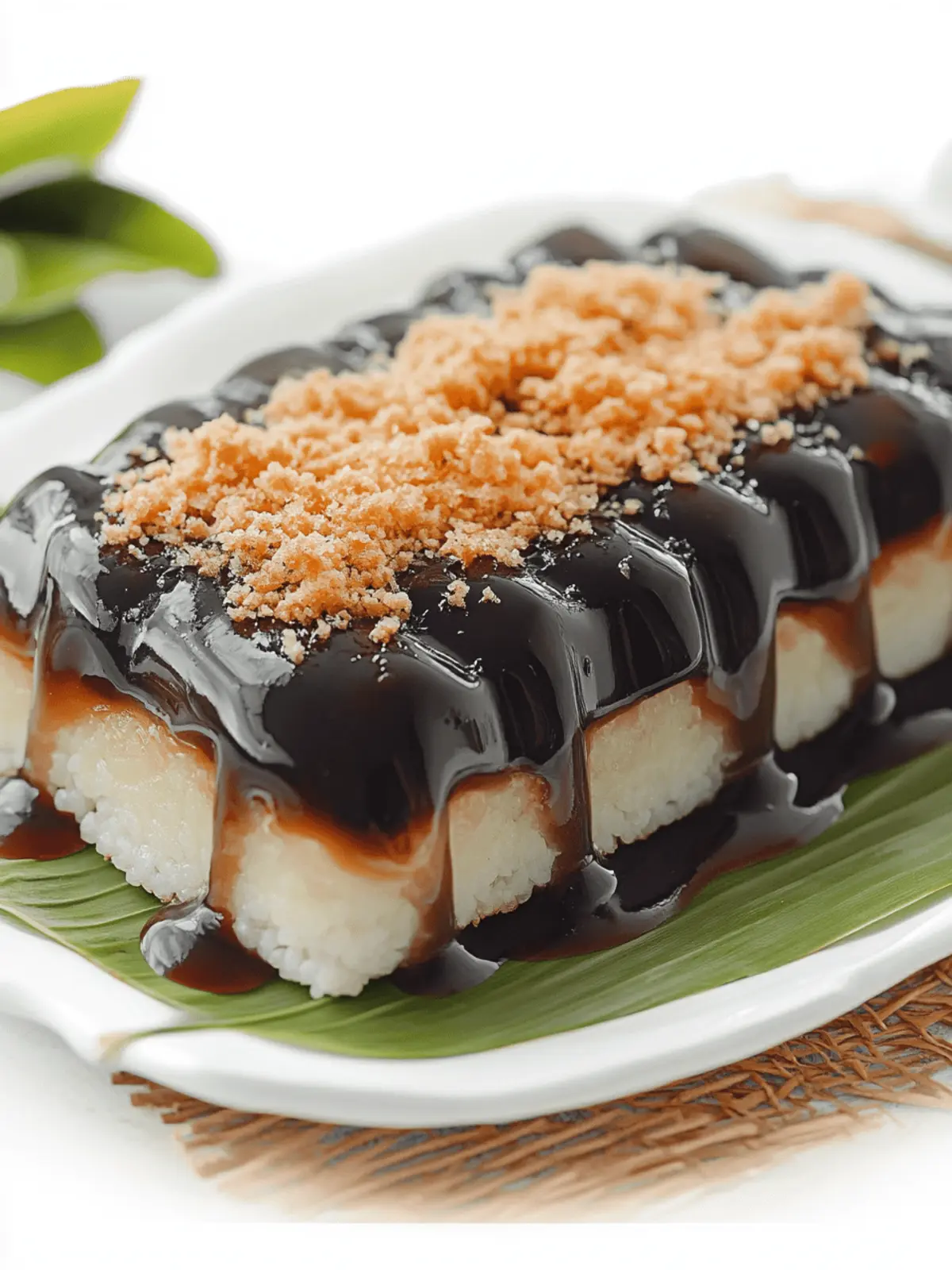The moment you step into a kitchen filled with the aroma of sweet coconut and rich ube, you know something special is happening. Sapin-Sapin, a traditional Filipino layered rice cake, is not just a dessert; it’s an experience, a vibrant ode to Filipino hospitality that brings family and friends together. Each colorful layer, lovingly crafted from glutinous rice flour and coconut milk, dances on the palate with delightful variations like creamy jackfruit and the unmistakable earthy sweetness of purple yam.
After a long week of fast food and mundane meals, I sought to brighten my kitchen with this festive treat. The first time I made Sapin-Sapin, it was like unwrapping a present stacked with joy, flavor, and a hint of nostalgia. The soft, custard-like texture makes it an ideal centerpiece for any gathering, drawing smiles and sparking stories. Plus, it’s gluten-free, allowing even more friends to join in on the celebration! Let’s dive into how you can create your own layers of happiness with this stunning dessert that will leave everyone begging for another slice.
Why is Filipino Sapin-Sapin so beloved?
Vibrant Colors: With its eye-catching pastel layers, Sapin-Sapin is a feast for the eyes and adds a festive touch to any table.
Uniquely Filipino: This traditional dessert embodies Filipino culture, making it a cherished favorite during celebrations and gatherings.
Customizable Flavors: Mix and match with unique flavors like ube or jackfruit for a delightful twist. You can even try adding pumpkin or matcha for a creative spin!
Simple Preparation: The straightforward steaming method is perfect for both beginners and seasoned chefs, making it accessible to everyone.
Crowd-Pleasing: Its irresistible taste and texture will surely impress family and friends, ensuring it becomes the star of your next dessert spread.
Filipino Sapin-Sapin Ingredients
For the Batter
- Glutinous Rice Flour – Provides structure and chewiness; you can substitute with mochiko or sweet rice flour if necessary.
- Rice Flour – Adds lightness to the batter; can be replaced with more glutinous rice flour for a denser texture.
- Coconut Milk – Contributes rich creaminess; opt for thick canned coconut milk for the best result or dilute with water if it’s too thick.
- Coconut Cream – Used for preparing latik topping; can substitute with additional coconut milk for a lighter dessert.
- White Sugar – Sweetens without overpowering; brown sugar offers a deeper flavor if preferred.
- Vanilla Extract – Enhances overall sweetness and flavor; it’s optional but highly recommended.
- Salt – Balances sweetness; feel free to omit for a low-sodium option.
For the Flavor Layers
- Ube Halaya – Purple yam jam adds vibrant flavor and color for the purple layer; choose store-bought or homemade versions.
- Jackfruit Puree – Introduces a tropical note to the yellow layer; use fresh or canned jackfruit for convenience.
- Yellow Food Coloring (optional) – Brightens the jackfruit layer; use sparingly if a more vibrant color is desired.
For the Topping
- Coconut Cream (for Latik) – Used to create a crunchy topping; sweeten with extra sugar if you like it sweeter.
With these ingredients, you’re well on your way to creating a delightful Filipino Sapin-Sapin that will impress all your loved ones!
How to Make Filipino Sapin-Sapin
-
Prepare the latik: In a saucepan, simmer coconut cream over medium heat, stirring occasionally, until golden brown curds form. Strain the mixture through a fine sieve and set the crunchy topping aside.
-
Mix the batter: In a large bowl, combine glutinous rice flour, rice flour, sugar, and salt. Gradually whisk in coconut milk until the mixture is smooth and creamy. Stir in the vanilla extract for extra flavor.
-
Divide the batter: Split the batter into three equal portions. Leave one portion plain, mix ube halaya into the second, and stir jackfruit puree (and optional coloring) into the third, creating three vibrant flavors.
-
Prepare the steamer: Grease a round pan to prevent sticking and preheat your steamer over high heat. Ensure there’s enough water in the bottom to prevent it from running dry.
-
Steam the purple layer: Pour the purple batter into the greased pan and steam it for 15-20 minutes, or until the surface appears firm and set; cover with a cloth to keep out condensation.
-
Add the jackfruit layer: Carefully layer the jackfruit batter over the purple layer and steam again for another 15-20 minutes, allowing it to firm up completely.
-
Finish with the plain layer: Finally, pour the plain batter into the pan and steam for an additional 25-30 minutes until the entire cake is fully set and cooked through.
-
Cool and assemble: Once done, allow the cake to cool completely in the pan. Gently loosen the edges with a knife before carefully turning it out onto a platter.
-
Add the finishing touches: Brush the top with coconut oil to enhance the flavor, sprinkle with the prepared latik, and cut the cake into wedges for serving.
Optional: Serve with fresh fruit or alongside a cup of sweetened coffee or tea for an extra treat.
Exact quantities are listed in the recipe card below.
What to Serve with Filipino Sapin-Sapin?
Elevate your dessert experience with delightful accompaniments that complement the vibrant layers of this traditional cake.
-
Fresh Tropical Fruit: Sliced mango or banana enhances the cake’s flavors, adding a refreshing contrast to the sweet layers. Their natural sweetness brings a sunny touch to the table.
-
Sweetened Coffee or Tea: A cup of coffee or a warm cup of jasmine tea pairs beautifully with the Sapin-Sapin, creating a balance of flavors that warms the heart.
-
Coconut Macaroons: These chewy coconut delights mirror the flavor profile of the cake, allowing you to indulge in a coconut experience. Their texture adds a delightful crunch to your plate.
-
Buko Pandan Salad: This creamy salad, made with young coconut and pandan leaves, is a perfect sidekick. Its lightness contrasts well with the layered richness of Sapin-Sapin.
-
Mango Float: A chilled dessert with layers of ripe mango, creamy filling, and graham crackers creates a beautiful harmony. Both desserts shine together in a tropical symphony.
-
Ube Ice Cream: Complement the cake with a scoop of ube ice cream to enhance the nostalgic feel. It’s a dreamy pairing that adds coolness and creaminess to each bite.
-
Coconut Fruit Shake: A refreshing coconut shake serves as a delightful drink alongside your Sapin-Sapin. Its creamy texture perfectly mirrors the dessert, offering a delicious combo.
Tips for the Best Filipino Sapin-Sapin
-
Layer Patience: Ensure each layer is completely set before pouring the next. This prevents the colors from bleeding into one another and keeps each layer distinct.
-
Smooth Transitions: Use a spatula to smooth the surface of each layer before steaming. This will give your Filipino Sapin-Sapin a polished, professional look.
-
Clean Cuts: Wipe your knife clean between cuts for neat, beautiful slices. This not only enhances presentation but also highlights the colorful layers beautifully.
-
Ingredient Quality: Always use high-quality coconut milk and fresh ingredients. This ensures that the flavors shine and brings authenticity to your dessert.
-
Experiment with Flavors: Feel free to mix and match flavors! Adding variations like matcha or fresh fruit purees can personalize your Sapin-Sapin, making it unique to your taste.
Filipino Sapin-Sapin Variations
Feel free to explore and personalize your Sapin-Sapin with these delightful twists that cater to your taste buds.
-
Pumpkin Puree: Swap out ube for a vibrant pumpkin puree to bring a seasonal flavor to each layer.
-
Matcha Magic: Add matcha powder to one layer for a unique flavor and striking green contrast against the traditional colors.
-
Choco Layer: Incorporate cocoa powder in the plain batter for a chocolatey layer that will delight dessert lovers.
-
Coconut Flavored: Enhance the coconut flavor by substituting coconut milk with coconut cream for an even richer taste and texture.
-
Fruit Medley: Use fresh fruit purees like mango or strawberry for a fresh twist; simply blend them into the batter.
-
Maple Sweetness: Replace white sugar with maple syrup to add a warm, earthy sweetness to the layers.
-
Exotic Spices: Spice up your layers with cinnamon or cardamom for a fragrant twist that’s sure to spark conversation.
-
Nutty Crumble: Top your Sapin-Sapin with crushed nuts like toasted almonds or walnuts for a delightful crunch contrast against the soft layers.
With these variations, every slice of your Sapin-Sapin can tell a different story, making it a dessert that’s uniquely yours!
Storage Tips for Filipino Sapin-Sapin
Room Temperature: Keep Filipino Sapin-Sapin covered at room temperature for up to 6 hours if serving soon. Avoid direct sunlight to maintain its delightful texture.
Fridge: Store the layered rice cake in an airtight container in the fridge for up to 3 days, ensuring it remains fresh and moist.
Freezer: For longer storage, freeze the Sapin-Sapin by wrapping it tightly in plastic wrap followed by aluminum foil. It can last in the freezer for up to 2 months.
Reheating: To enjoy your frozen cake, thaw it overnight in the fridge. Reheat gently in the steamer for about 10-15 minutes to restore its soft texture.
Make Ahead Options
Sapin-Sapin is perfect for meal prep enthusiasts! You can prepare the individual layers up to 24 hours in advance, allowing you to enjoy this delightful Filipino layered rice cake without the stress of last-minute cooking. To prep ahead, steam the purple, jackfruit, and plain layers as instructed and let them cool completely before wrapping them tightly in plastic wrap. Refrigerate the layered cake for up to 3 days. When you’re ready to serve, simply let it come to room temperature, brush with coconut oil, and sprinkle the latik topping. Your guests will be amazed at how just as delicious this make-ahead treat can be, saving you time and ensuring a stunning dessert is ready to impress!
Filipino Sapin-Sapin Recipe FAQs
What type of glutinous rice flour should I use?
You should use authentic glutinous rice flour, which is essential for achieving that delightful chewy texture in your Filipino Sapin-Sapin. If it’s hard to find, you can substitute with mochiko or sweet rice flour, but ensure it’s specifically marked as glutinous.
How can I store leftover Sapin-Sapin?
To keep your Filipino Sapin-Sapin fresh, store it in an airtight container in the refrigerator for up to 3 days. It remains moist and delicious, making it easy to enjoy as a snack or dessert later. If you want to keep it longer, I recommend freezing it.
Can I freeze Sapin-Sapin?
Absolutely! To freeze your Filipino Sapin-Sapin, tightly wrap it in plastic wrap and then in aluminum foil. This helps prevent freezer burn and preserves its delightful texture. It can last in the freezer for up to 2 months. When ready to enjoy, thaw in the fridge overnight and steam it for about 10-15 minutes to regain its soft, beautiful layers.
What should I do if the layers mix together?
If you find that the layers of your Sapin-Sapin did not set correctly and mixed together, don’t worry! This sometimes happens when the steaming time was not sufficient. Ensure that each layer is fully set before adding the next. Use a gentle touch and allow each layer to cool slightly before layering to ensure a perfect rainbow of colors.
Is Sapin-Sapin safe for my dog?
While Sapin-Sapin is made from safe ingredients like rice and coconut, it’s best to avoid giving it to your dog. The added sugar and coconut milk may not sit well with their digestive system. Always consult with your veterinarian if you’re unsure about introducing new foods to your pet’s diet.
How can I add a twist to my Sapin-Sapin?
You can get creative with flavors! Besides using ube and jackfruit, feel free to experiment with pumpkin puree for a seasonal take or matcha for a vibrant green layer. You can also incorporate fresh fruit purees to add a natural sweetness and a burst of flavor, giving your Filipino Sapin-Sapin a unique personality.

Filipino Sapin-Sapin: Delightfully Layered Rice Cake Recipe
Ingredients
Equipment
Method
- Prepare the latik: In a saucepan, simmer coconut cream over medium heat, stirring occasionally, until golden brown curds form.
- Strain the mixture through a fine sieve and set the crunchy topping aside.
- Mix the batter: In a large bowl, combine glutinous rice flour, rice flour, sugar, and salt.
- Gradually whisk in coconut milk until the mixture is smooth and creamy. Stir in the vanilla extract.
- Divide the batter into three equal portions. Leave one portion plain, mix ube halaya into the second, and stir jackfruit puree (and optional coloring) into the third.
- Prepare the steamer: Grease a round pan, preheat your steamer, and ensure there’s enough water in the bottom.
- Steam the purple layer: Pour the purple batter into the greased pan and steam for 15-20 minutes.
- Add the jackfruit layer: Layer the jackfruit batter over the purple layer and steam again for another 15-20 minutes.
- Finish with the plain layer: Pour the plain batter into the pan and steam for an additional 25-30 minutes.
- Cool and assemble: Allow the cake to cool completely in the pan.
- Add the finishing touches: Brush with coconut oil, sprinkle with latik, and cut into wedges.






